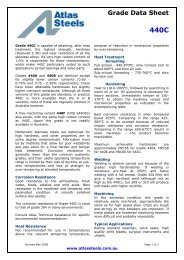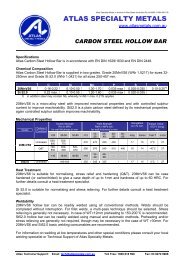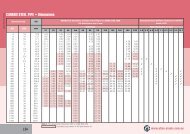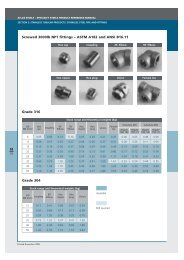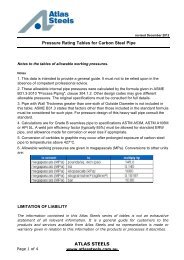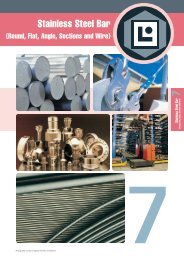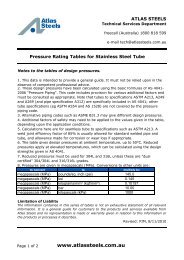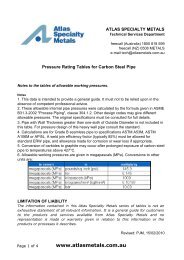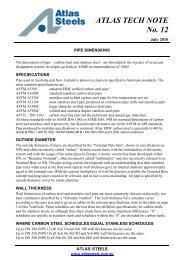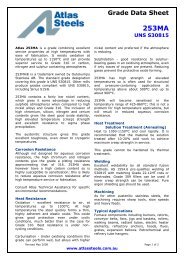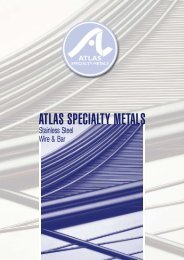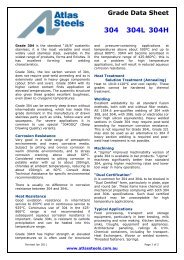Through-Hardening Low Alloy Steel Bar 4340 - Atlas Steels
Through-Hardening Low Alloy Steel Bar 4340 - Atlas Steels
Through-Hardening Low Alloy Steel Bar 4340 - Atlas Steels
You also want an ePaper? Increase the reach of your titles
YUMPU automatically turns print PDFs into web optimized ePapers that Google loves.
<strong>Atlas</strong> Specialty Metals<strong>Through</strong>-<strong>Hardening</strong> <strong>Low</strong> <strong>Alloy</strong><strong>Steel</strong> <strong>Bar</strong> <strong>4340</strong>Machining allowances for <strong>Atlas</strong> <strong>4340</strong> round bar (mm on diameter)<strong>Bar</strong> diameterBlack (hot rolled or forged) Bright (drawn or peeled bar)(mm) part length120mmpart length120mm0-50 1.5mm 1.5 + 6mm/m 1.0mm 1.0 + 4mm/m50-100 2.3mm 2.3 + 6mm/m 1.0mm 1.0 + 4mm/m100-150 4.5mm 4.5 + 6mm/m 1.0mm 1.0 + 4mm/m150-210 6.5mm 6.5 + 6mm/m 1.5mm 1.5 + 4mm/m210-450 - - 1.5mm 1.5 + 6mm/mHot-rolling surface defects are retained in cold drawing. For bright bar in the range ofcold drawing (up to 50mm) it is essential to take machining allowance into account.Peeled bar is generally free of surface defects. A certain allowance for surface defectsis recommended however, as minor defects are permitted by the various nationalstandards (AS, EN, etc.).Heat TreatmentAnnealing Normalising <strong>Hardening</strong>QuenchingmediumTempering850°C 850 – 920°C 850 – 860°C Oil 450 – 650°CTensile Strength (MPa)1600140012001000800600Tempering Diagram <strong>4340</strong>typical values for 30 mm sectionTensileStrengthElongationIzodImpactRed. ofArea400 500 600 700Tempering Temp (°C)1009080706050403020100Elongation (A%), Red of Area (Z%) andIzod Impact (J)<strong>Hardening</strong>Heat components slowly to850°C, hold until uniform thenquench vigorously in oil (orpolymer with an equivalentquench rate) to between 80and 110°C.TemperingWhile still warm, re-heat to 450to 650°C, hold one hour per25mm of section (2 hoursminimum) and cool in air.Select tempering temperaturesaccording to the requiredmechanical properties – referto tempering curve.Stress relievingFor pre-hardened steel stressrelieving is achieved by heatingto between 500 to 550°C. Retreatedbars or forgings heat to25°C below temperingtemperature. Annealedcomponents, 600 to 650°C.Hold in this temperature rangefor 1 to 2 hours, furnace coolto 450°C, then air cool.Revised April 2006 2 of 3
<strong>Atlas</strong> Specialty Metals<strong>Through</strong>-<strong>Hardening</strong> <strong>Low</strong> <strong>Alloy</strong><strong>Steel</strong> <strong>Bar</strong> <strong>4340</strong>Surface <strong>Hardening</strong>NitridingNitride at approximately 510°C for 10 to 60 hours, depending upon required case.Surface hardness achievable is 600 to 650HV.Induction or Flame <strong>Hardening</strong><strong>Atlas</strong> <strong>4340</strong> can be surface hardened to 58HRC (water quench) or surface hardened tobetween 53 to 55HRC (oil quench). Tempering at 200°C.WeldingWelding is not recommended because of the danger of quench cracking. If weldingmust be carried out, pre-heat to 200 to 300°C and maintain this while welding.Immediately after welding stress relieve at 550 to 650°C.Applications of <strong>Atlas</strong> <strong>4340</strong>Parts exposed to high permanent and fluctuating stresses. Applications whereexcellent fatigue and toughness properties of the material are required. Typicalcomponents include gears, planetary gears, axles, pinions, shafts, bushes andsleeves.Hardenability Diagram65Hardenability of <strong>4340</strong>Typical Jominy Test Results according to AS 1444Rockwell hardness (HRC)60555045maxmin400 1.5 3 5 7 9 11 13 15 20 25 30 35 40 45distance from quenched end (mm)Possible Alternative GradesGrade Why it might be chosen instead of <strong>Atlas</strong> <strong>4340</strong><strong>Atlas</strong> 4140 <strong>Low</strong>er cost and better availability in a range of sizes. However, ingeneral slightly lower impact properties achieved when heat-treatedto similar strength levels as <strong>4340</strong>.<strong>Atlas</strong> 6582 Superior impact properties and through-hardening when heat-treatedto similar strength levels as <strong>4340</strong>.<strong>Atlas</strong> 6580 Substantially higher yield strength achievable, especially in largersections, when heat treated to similar impact properties as <strong>4340</strong>.Higher toughness is also achieved in <strong>Atlas</strong> 6580.DisclaimerWhilst every effort has been made to ensure accuracy of the information in this Datasheet, <strong>Atlas</strong> SpecialtyMetals accepts no liability for damages arising from its use.Revised April 2006 3 of 3



